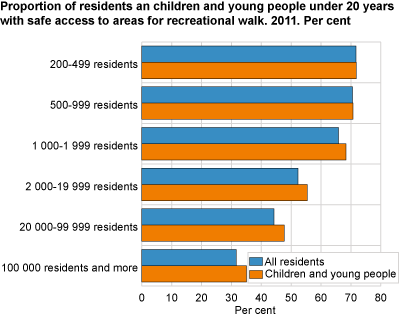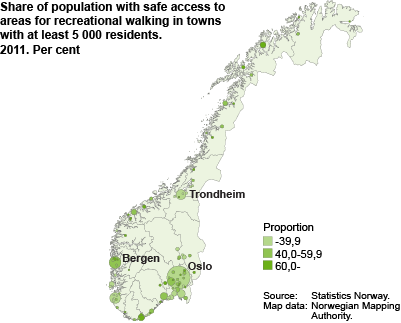Content
Published:
This is an archived release.
Big cities - less access
Residents of the largest cities have poorer access to areas for recreational walking compared with residents in smaller cities. This is also the case regarding access to smaller recreational areas, but the difference is smaller.
Around 44 per cent of residents in all urban settlements have safe access to areas for recreational walking, while close to 43 per cent have safe access to smaller recreational areas. There is a somewhat higher percentage with access among children and young people under the age of 20. The figures are based on an analysis of new land use statistics .
Some key definitionsArea for recreational walking Large nature areas (bigger than 20 hectares) within or bordering urban settlements. Parks and most sports fields are also included. Recreational area Large nature areas (at least 5 hectares) within or bordering urban settlements. Parks and most sports fields are also included. Safe access To reach an area safely, it must be possible to traverse along paths, footpaths and cycle paths or regular roads with low traffic and low speed limits. There are also criteria regarding how long a person should walk to reach areas for recreational walking (maximum 500 m) and recreational areas (maximum 200 m). ”About the statistics” describes the statistics in more detail. |
There can be major differences between one urban settlement and another. However, there is a clear connection between the share with access and urban settlement size. The share with access is lower in big cities. Seventy-two per cent of the residents in the smallest urban settlements have access (59 per cent with access to areas for recreational walking), while 32 per cent of residents in the biggest cities have access (36 per cent to areas for recreational walking).
Part of the reason for the difference between urban settlements of unlike size is that most of the areas for recreational walking are located outside urban settlements. In small urban settlements there is a shorter distance to the urban settlement border compared to larger settlements. Big urban settlements are also more densely built up and have more roads with high traffic. This, in turn, contributes to the lower share of residents in bigger urban settlements with access also observed regarding recreational areas.
More children have access
More children and young people have access to recreational areas and areas for recreational walking than the population at large (3-4 percentage points). This is because children tend to live closer to recreational areas serviced by footpaths and cycle paths and other low traffic roads. The smallest urban settlements have no notable difference between children and the adult population.
115 square metres per resident
The total recreational area within urban settlements is around 450 km2. Residents in urban settlements have an average of 115 m2 of recreational area each. Residents in the biggest urban settlements have on average least recreational area at their disposal.
Protection of outdoor areas
The government has for years protected outdoor areas through acquisitions or through long-term agreements. This applies to all types of valuable outdoor areas, not just recreational areas and areas for recreational walking. An overview of the Directorate for Nature Management’s “Naturbase” shows that, as of 2012, there is a total area of secured areas of about 424 km2 in Norway. About 25 per cent of the state secured outdoor area is within areas for recreational walking, while about 7 per cent is in recreational areas as defined in these statistics.
Just over 1 per cent of the recreational area is secured state recreational area.
Important with green areas close to dwellings, schools and kindergartensIn addition to nature and environmental change, the existence of nearby outdoor green spaces will contribute to physical activity. According to the Norwegian Institute of Public Health, outdoor physical activity has positive health effects, including in relation to circulation, lungs and muscles. It is also shown that physical activity reduces the risk and symptoms of some diseases. Even minimal activity is good for your health. Children who have a natural setting that offers a variety of activities show better physical development than children who have more cultivated and function-specific environments. In its knowledge overview of the environment and health, the Norwegian Institute of Public Health (2009) describes how the exploitation of green spaces falls as the distance to residential areas increases. In particular, children's action radius is limited. In play and unorganised activity during leisure time, most 5-6 year-olds stay within 100 metres of their own home. Increased population density in cities and towns is in accordance with the national goal of a more concentrated development in order to reduce transportation and climate gas emission. Concentrated development can however lead to reduction of green areas and reduce access to recreational areas. New regular statisticsIn recent years, more detailed data sources have become available, which has provided a basis for improved land use statistics. This enables us to identify and delineate more precisely the green areas that are included in the statistics on access to recreation areas and areas for recreational walking. Statistics Norway has established new, regular statistics on access to recreational areas and areas for recreational walking. The statistics cover two of the key figures given in the national targets for the outdoors, see more in white papers (for example, White Paper No. 26 (2006-2007)), with subsequent adjustments. |
Additional information
The data source for recreational areas is the land use and land cover map for Norway. More on this data set and associated statistics in the link below.
Contact
-
Tom Anders Engebakken
E-mail: tom.engebakken@ssb.no
tel.: (+47) 47 46 47 66
-
Jørn Kristian Undelstvedt
E-mail: jorn.kristian.undelstvedt@ssb.no
tel.: (+47) 94 50 68 64


